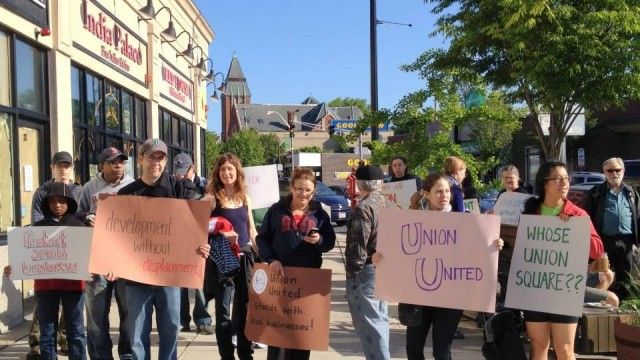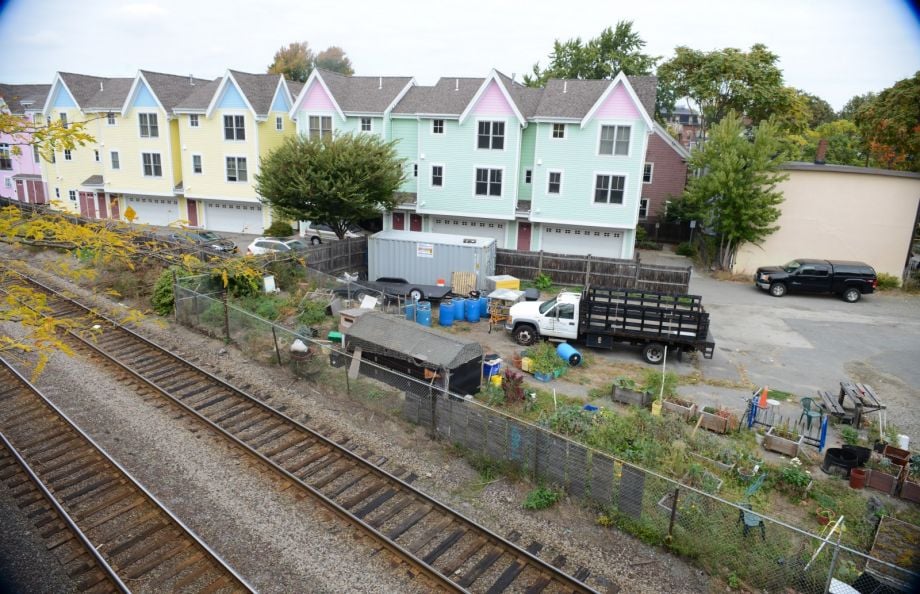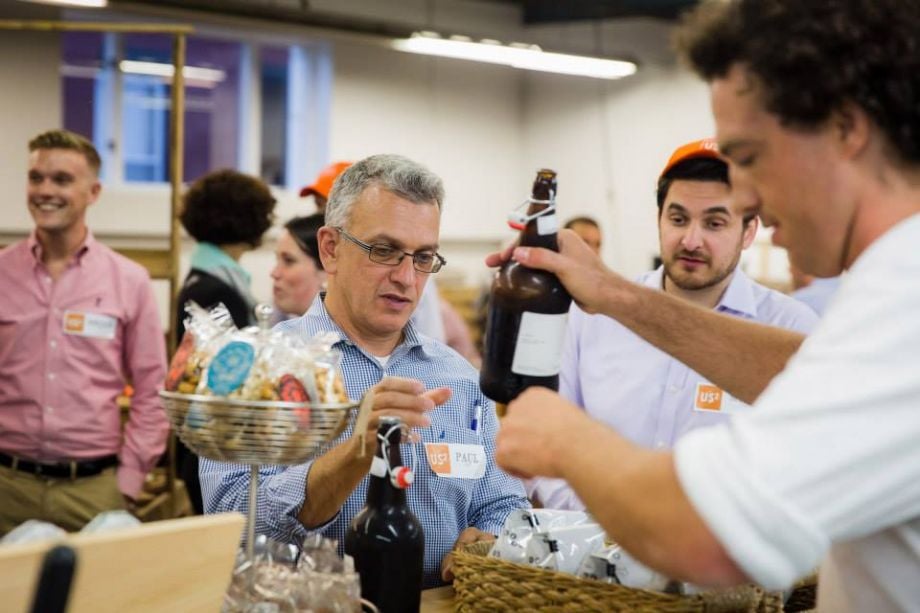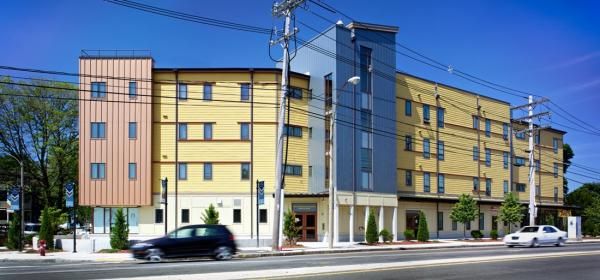Are You A Vanguard? Applications Now Open
The narrow conference room near the entrance of Somerville Community Corporation’s headquarters is packed tight.
Young professionals in button-downs and dress shoes crowd next to neighbors in jeans and t-shirts. On a hot July night, they squeeze against scuffed walls and snack on homemade pupusas as they chat about new developments popping up all over Somerville, the rising rents, the unfamiliar neighbors. The head of the local municipal workers union surveys the room. His t-shirt declares, “In Unity There Is Strength.”
The crowd is diverse in almost every conceivable sense of the word: the spiky-haired owner of a Crossfit gym, several elderly life-long Somerville residents, a group of Creole-speaking Haitian women. A man in a Red Sox cap speaks Spanish into his headset, translating for the numerous earbud-fitted Hispanic participants who want to ensure they don’t miss a word of the evening’s conversation about the redevelopment of the city’s Union Square neighborhood.
“Usually gentrification just happens by accident,” said Mark Tomizawa to the elderly man seated close beside him. “I’ve lived in Chicago, Philadelphia, Miami and New York, and I’ve never seen anything like this.”
Somerville is a small, densely populated city on the northern border of Cambridge. Thanks to its proximity to Harvard and a reputation for affordability and diversity, Somerville’s tightly packed residential neighborhoods have gradually over the last several decades become a go-to nesting ground for a certain breed of well-educated, upwardly mobile Bostonite. The pace of change is accelerating dramatically as the city’s transit department moves forward with a long-anticipated expansion of the Massachusetts Bay Transportation Authority’s Green Line light rail.
The rail expansion will give many Somerville residents — and the new neighbors certain to be drawn by the transit amenity— their first shot at a relatively painless commute into Boston via five new rail stations. Among them is a stop in hip Union Square poised to be a catalyst for millions of square feet of new development in a section of the neighborhood long dominated by industry, now dotted with vacant tracts of contaminated land.

This composite image shows the light industry taking place on the site of the future Green Line station. The vacant lot at right is a city-owned brownfield to be cleaned for the new development.
In June, city officials selected a Chicago venture called Union Square Station Associates (US2) to be the project’s master developer. With major residential and commercial projects in some of Chicago’s most prime areas under its belt, the out-of-towners beat out local developers for the job of remaking seven blocks near the new Union Square station with 2.3 million square feet of offices, shops, homes and open space. The plan is to reinvent the 12-acre area as a vibrant mixed-use neighborhood with density to meet the city’s growing needs. If all goes forward as planned, the $1 billion project will be a huge win but one that comes with a set of new challenges, namely how to keep Somerville affordable enough for the people who live there now.
“When the Green Line comes through, this could become an almost entirely professional upper-middle-class and above community,” said Somerville Mayor Joseph Curtatone in a call with reporters in late October. If the city does not act, he said, Somerville “might still be diverse ethnically and racially, but in terms of who can live here we would only have people who can make $100,000 or more. … That’s not we want. That’s not what the city is.”
One of the Mayor’s allies in avoiding that fate is Somerville Community Corporation, host of the well-attended July meeting about the Union Square development. SCC is a membership-based non-profit organization that has been providing service for low-income city residents since 1969, first running a soup kitchen and doing housing advocacy work before moving into affordable housing development in the 1980s.
Six month ago, the non-profit began organizing a new coalition focused solely on Union Square. Named Union United, the coalition quickly amassed buy-in from local labor unions, including SEIU Local 888 and the International Brotherhood of Electrical Workers as well as small businesses in the neighborhood, churches and various non-profits serving the city’s immigrant communities.
Instead of opposing new development or engaging in combative dialogue with the developers, Union United is trying to cut its own deal — and in the process, influence how development happens over the long-term in its growing city.
Afruza Akther has lived in Union Square for 11 years and joined Union United this summer. She works at a Subway franchise nearby and sends her daughter to elementary school in the neighborhood. “I moved last month, the rent went from $1,200 to $1,700 for a two-bedroom apartment,” she said in a recent interview. “It’s hard to stay and it’s not just me experiencing this. We want to talk to the people who have the power to make a difference. If we don’t say what we need now they will say later where were you before this happened.”
Union United wants to sign a legally binding community benefits agreement with the Chicago development team. Popularized in the 1990s and 2000s by neighborhood advocates and labor unions, community benefits agreements are a means of holding developers accountable to the promises of jobs, affordable housing and other services made when local approval is needed during the early stages of big projects. Though CBAs are often discussed when major development is proposed, the agreements remain relatively rare.
In Somerville, US2 is receptive to the idea of a CBA and has met with Union United as well as myriad other community groups and advisory councils. But the developer, not surprisingly, is first and foremost focused on negotiating with the city and an appointed Union Square Civic Advisory Committee, which will serve as the official community partner in the months-long public planning process that must happen before anything is built.
The public process will determine exactly what exactly is included within that 2.3 million square feet of planned development — the exact mix of housing, commercial and public uses, building height and open space has yet to be decided. The community benefits agreement that is ultimately signed will be with the city and negotiated through the process, US2 has said.
US2’s chief urban planner David Dixon is upfront about the difficult balance the project must strike in order to satisfy the desires of all the players. Union United, with its anti-gentrification agenda, isn’t, after all, the only constituency being served by the project.
To shore up its tax base and remain stable, Somerville needs residents willing to buy market-rate housing, open businesses and create jobs.
Increasing the area’s density is critical to curbing sprawl, reducing car traffic and accommodating a growing regional population, key goals of the transit expansion.
A presentation the developer showed the city in May as part of its wooing imagines the remade Union Square as a thriving hub of co-working spaces, container park popups a la Downtown Las Vegas’ Tony Hsieh and glassy office towers for “innovation workers” pictured as fresh-faced, mostly white millennials. It probably isn’t exactly the vision Union United would conjure but that doesn’t mean there isn’t room for the coalition’s needs to be met within the millions of square feet of new development.
“To be successful, this needs to be transit-oriented development without gentrification, without displacement,” said Dixon. “Development that really does bring the benefits of significant new investment to a neighborhood in ways that preserve authenticity.”
But it’s an open question whether a small and already crowded city in the midst of a regional housing boom can resist the inexorable trend of market forces. Theorists like Edward Glaeser, author of “Triumph of the City: How Our Greatest Invention Makes Us Richer, Smarter, Greener, Healthier and Happier,” have long prophesied that density will keep housing costs low. In Somerville, that faith is being tested.
Union Square Station Associates has not skimped on talent as it moves forward with its plan for Somerville. A joint venture comprised of two high-profile Chicago firms, Magellan Development and Mesirow Financial, US2 brought in Jeanne Gang, an internationally renowned designer and recipient of a 2011 MacArthur Genius Grant, as well as Meejin Yoon, who heads MIT’s architecture department. Former Boston City Councilor Paul Scapicchio serves as a strategic advisor.
Meanwhile, working community relations is Jamie Chisholm, who made his name as chief of staff to Boston City Councilor-at-Large Ayanna Pressley, the first woman of color elected to the council. Chief Urban Planner David Dixon, who rose to national prominence for his work in post-Katrina New Orleans, has a strong reputation and long history of work in the region.
Soon after winning the contract, the developer put up a website proclaiming its mission to work with the Mayor and community to create “new jobs, public green spaces and homes within a range of affordability … while preserving the historical character and ‘funk’ that everybody loves today.” There are multiple calls for public engagement — like “send us your ideas.” In August, the team began a campaign of community meetings branded “100 Days of Engagement.”
Back in July, the Somerville residents who came to the Union United meeting were excited to talk about each element of the development and its correlating community benefit — jobs for residents, green space, room for local small businesses and, especially, affordable housing. As the gathering broke up, a handful of people hung around joking and polishing off the pupusas. They seemed energized by the prospect of a massive development with a bit of their imprint. “In all of greater Boston this place is going to be the trendsetter,” said one person.
Being on top of a trend is nothing new to Somerville. The neighborhood-centric city, population 79,000, has quietly been at the forefront of many of the shifts reshaping urban America, particularly its first-ring suburbs. It is denser than San Francisco, with well over 18,000 people packed into each of its 4.2 square miles. It is the densest municipality in New England and as of 2010, the 15th densest municipality in the U.S., sandwiched between two cities in Los Angeles County.
Neighborhoods range from Union Square, with its mixture of bodegas, venerable restaurants, coffee shops and small businesses to upscale Davis Square, which is just one $14-a-drink cocktail bar removed from Harvard Square.
The northeastern section of the city contains Assembly Square, once home to a massive Ford factory and now site of another major redevelopment project tied to last month’s opening of another new MBTA station, Assembly Station. Nearby, sits immigrant-dominated East Somerville. Walking down that neighborhood’s main drag, Broadway, feels a world apart from Davis Square. Taquerias, laundromats, pupuserias, corner stores and Brazilian eateries are laced with older Italian restaurants and Irish pubs, most of them sheltered in aging buildings.
Somerville’s population peaked in 1930 at nearly 104,000. After World War II, the local economy began a steady decline familiar to industrial communities across America, and families began leaving for greener suburban pastures or larger cities. The Assembly Square Ford facility closed, emblematic of the city’s shrinking manufacturing sector as capital fled south. Since then Somerville’s commercial tax base has been minimal, with most residents forced to find employment outside the city.
Locals bridled under the hated epithet “Slummerville,” which caught on in the postwar years as Somerville suffered the indignities of divestment. Many blocks were marred by blight, boarded-up houses were commonplace. “You couldn’t give [property] in Somerville away,” remembers Irene Bremis, who began selling real estate in the area in 1984. But the cheap housing appealed to immigrants, predominantly from Brazil, Central America and Haiti, the first people of color to live in significant numbers within the city. By 2000, Somerville’s population was more than 25 percent non-white.
The affordability that drew immigrants to Somerville was predicated, in part, on the fact that it lacked an essential urban amenity. Unlike Cambridge, which is threaded with subway stops, Somerville didn’t have a single rail connection until 1984, when the Red Line was extended to Davis Square. Today Davis Square is noticeably different than much of the rest of Somerville, especially the eastern neighborhoods. Chain retailers and upscale restaurants fill the streets. Graduate students share rambling homes, their compact cars and U-locked bicycles parked on busy streets. A 2013 report from the mayor’s office found that Davis Square’s population is 88 percent white, in contrast with a citywide 74 percent, while median household income is $80,255 in comparison to a citywide median of $66,019.
In the late 1990s, with Boston’s revitalization as a tech and biomedical hub well underway, Somerville’s advantageous geographic position began to drive the cost of housing up in the rest of the city. In 1995 the median home sale price was $115,000, according to data provided by online real estate company Redfin, but by 2000 it had shot up to $245,000. There have been a few years since when sale prices dropped, but the trend is ever upwards and the median hasn’t fallen below $350,000 since 2005.
Today, the Boston area housing market is among the most expensive in the nation, up there with San Francisco and New York. An early 2014 study from the Cleveland Federal Reserve found fully one-fourth of Boston’s population living in gentrifying neighborhoods, a far greater percentage than any other city.
In Somerville, the demographics point to a particular vulnerability; 67 percent of the population rents housing and 44 percent of them spend more than 30 percent of their income on their rent.
In 2006, the Somerville School District began interviewing parents who were pulling their children out of the system. Many moving away from Somerville cited increasing housing costs: Roughly 40 percent said they were leaving the city for reasons of affordability. The most recent sale numbers, for 2013, show a median sales price of $422,000. There is every indication that prices have only gone up since then.
“We’ve had two or three increases in housing prices before, but this is beyond anything anyone’s ever seen,” said Mark Niedergang, a recently elected alderman representing Ward 5 in western Somerville and the owner of two houses in the city. “I’ve been here 30 years, but people who have been here 50 or 60 years are seeing single-family houses go for $1 million and it is mind-boggling to them. They bought for $25,000 back in 1970.”
Niedergang has seen all kinds of market fluctuations over his three decades in Somerville but this latest boom is different, he said. In the past, he would receive the occasional letter from an investor or realtor offering to buy his home, but now with the Green Line coming and more development on the way, it’s a bombardment, he said. Investors are tripping over themselves trying to buy houses for cash.
“Somerville’s future is, in some ways, more or less regarded as inevitable,” said Anthony Flint, director of public affairs at the Lincoln Institute of Land Policy, based in Cambridge. “Concerns about a housing crisis are quite legitimate. Somerville is the next Cambridge and in a lot of ways it already is.”
Shawn Flynn, Redfin’s listing agent in Somerville, is a native of Cambridge who moved to Union Square last year. “The secret is out now,” he said. “People want to live in Union Square.”
Kelvin Mejia is an SCC member who has already found himself priced out of the city. “I just wanted to move to a quiet city and Somerville fit the bill,” said Mejia, who moved to Somerville in 2009 to escape a crime-ridden neighborhood in Jamaica Plain.
“I really love it. There’s lots of development going on everywhere, it’s looking great,” he said. “I really wish I could stick around.”
Until recently Mejia was living in what he calls a “one and a half bedroom” apartment in a converted garage with his girlfriend and daughter. (One bedroom had a closet and no heater, the other a heater and no closet.) Despite the apartment’s suboptimal qualities, it is within walking distance of Union Square. The landlord raised the rent every year, but this time he bumped it an additional $300 above the $1,200 they were already paying. Mejia had to move.

Union United is a coalition of local union members, small business owners and Union Square residents.
Many of Mejia’s neighbors and friends have experienced similar rent spikes. (The median rent recorded in American Community Survey data from 2013 was $1,502.) Rent regulations were banned by a statewide ballot initiative organized by real estate interests in 1994. Although the measure was voted down in the only three cities that employed such policies at the time — Boston, Brookline and Cambridge — it scraped by with 51 percent of the statewide vote.
Mejia recalls a friend who moved to Lynn, 30 miles outside Boston, when his landlord raised the rent by $200 a month. “That’s the cheapest rent you can find, but the transportation sucks,” said Mejia, who relocated his family to Dorchester, in Boston, when the rent got too high. “[In Lynn] it’s not like out here where you have trains and buses all over the place, over there it’s, like, one bus.”
For Mejia, it was particularly painful to pull his daughter from the Somerville public school system. “Today was her last day because we are moving on Tuesday to the new place,” he said in late September. “The teachers are great, there’s a lot of security, it’s a brand-new building. It’s just unfortunate we have to move when she just started. And it’s all due to the rent. Hopefully in a year I can save up and come back, because we really want to stay.”
A six-term mayor with a reputation as a progressive reformer, Mayor Curtatone is sensitive to the displacement going on. He made headlines in August when the city passed the largest residential tax break in the state, a move intended to help keep low-income families, seniors and others contending with rising tax assessments in their homes.
“This is no different than investing in any of the programs we have to help people in our community who are vulnerable,” the mayor told reporters in a published statement. “The property tax is perhaps the most regressive tax, levied without taking into account a taxpayer’s income or ability to pay the tax and disproportionately affecting the middle class, retirees and small businesses.”
Yet the tax break does little to change the current squeeze on renters like Meija.

New housing developments like this one have gradually been rising near Union Square but they are not nearly enough.
With the public planning process not yet underway, US2 isn’t ready to comment on how much affordable housing the development will include. The developer will adhere to whatever affordability requirements the public process ultimately generates, spokesman Jamie Chisholm said.
“We are incredibly mindful of the importance of creating diverse housing stock in Union Square, from traditional affordable housing to middle market housing to family-friendly 2-3 bedroom units,” he wrote in an email.
In September, Union United met with representatives of US2 and presented their priorities for the community benefits agreement. Meetings are ongoing.
“Honestly, when we meet [with Union United] and I see what they are looking at there are a lot of things in there that we are going to be in total agreement on,” Chisholm said in a recent interview. “They have a level of detail that is really impressive.”
Dixon, for one, seems eager to work with the city to figure out the right mix of affordable and market-rate housing. “The top 5 percent of households control 43 to 47 percent of consumption, so when it comes to urban housing, people with a lot of money could simply bid everyone else out of everything,” Dixon said. “This process [of gentrification] is going to happen no matter what. The Green Line [and the public development process tied to it] is certainly going to accelerate that but it will also bring huge benefits.”

Union Square Station Associates has been holding community meetings like this event at Aeronaut Brewing Company. (Photo credit: US2)
“[US2’s development] means you now have a flow of money that you can tap to pay for all these other public benefits that simply haven’t existed since WWII. In neighborhoods like Union Square there will be 20 years of substantial appreciation that we can tap for these benefits.”
Mayor Joseph Curtatone’s Twitter profile reads, “working 24/7 to make the American urban renaissance happen.” Clearly, he and Edward Glaeser, who teaches at Harvard less than a mile away from Union Square, share a love of cities. But where the two differ is in their approach to development.
Glaeser famously argues that deregulation of the housing market is the solution to ever-rising housing costs. For him, the solution to Somerville’s growing pains would be to let US2 build what it thinks the market can support — hopefully skyscrapers — then provide housing vouchers when the city’s residents can’t afford to live in the new towers.
Curtatone has taken an opposing tack. In 2009, he called for a series of community meetings to guide the city toward SomerVision, a strategic plan for Somerville’s future. The final 183-page version was released in 2012 and contained a call for 6,000 new units of housing, of which 20 percent, or 1,200 units, would be kept permanently affordable. In the years since, subsidizing affordable development has remained a focus of his administration with the Mayor increasing fees for commercial development to increase revenue for the city’s affordable housing trust and similarly, passing into law a property tax surcharge to go toward the same cause.
The city also has in place an affordable homeownership program designed to ensure that city-subsidized affordable housing stays that way. Houses sold through this program come with deed restrictions that prevent the owner from selling the home for values above a certain price and limit the amount of equity future owners can hold. Similar restrictions apply to city-subsidized affordable rentals.
“That is something somewhat unique about Somerville,” said Karen Narefsky, an organizer with SCC. “A lot of places have affordable housing units that expire after a couple of decades. Then you either lose the units or campaign to maintain them. It makes it much easier to lose affordable housing… In Somerville… the units that we build are permanently affordable.”
Still, the supply isn’t meeting demand. In August, Curtatone told me he no longer thought 6,000 units of affordable housing would do, suggesting that the number needed likely would be closer to 10,000. “We want everyone to have the opportunity to grow and prosper with us and not lose our soul along the way,” he said.
He has since made that commitment publicly as part of a “Sustainable Neighborhoods” initiative, a slate of regulatory proposals released in late October to address issues of affordability and displacement.
One of the less controversial policies would tweak the city’s inclusionary zoning policy, requiring developers to include more affordable units in any development larger than eight units. Currently, the policy demands 12.5 percent of units in a new development be kept available for low- or moderate-income residents and at that level, its impact has been relatively negligible, creating only 165 units of affordable housing over the last 24 years with another 252 on the way at Assembly Row, part of transit-oriented-development project now under construction in Assembly Square. Curtatone’s proposal would up the requirement to 20 percent.
Other changes, which will be tackled later this year, include Curtatone’s recommendation that all projects of an as yet unspecified size include family-size units in their inclusionary requirements — regardless of the size of the market-rate units. The Mayor is also considering incentives for smart growth in Somerville’s few underdeveloped neighborhoods and the creation of a “maker and artist district,” where creative types will be allowed to live in their workspace. It is possible that some of the new affordable housing supported by the city will be developed by Somerville Community Corporation, long a partner of the city on such projects.

Saint Polycarp Village is an affordable housing development built by Somerville Community Corporation with financial support from the city of Somerville. (photo credit: SCC)
The rest of the Sustainable Neighborhoods program would require the approval of the state legislature, which can be difficult terrain for urban-oriented policy.
Some ideas sound easier to implement than others. Who could challenge tax credits for “benevolent landlords”? The basic idea would be to offer property owners tax incentives to keep their rents artificially low according to a formula, which could be adjusted on an annual basis. (It’s like non-mandatory rent regulation, with incentives for participation.) The tougher sell will be a real estate transfer tax to repress real estate speculation, which Niedergang strongly supports. Under that proposal, if someone buys a property and sells it within a year they pay a 5 percent tax on the profits, in two years 4 percent, and so on. The proceeds would go toward the affordable housing trust fund.
“Some of those ideas are very bold,” said LeBlanc. “No negative reactions yet, but it’s a honeymoon period after the announcement [of Sustainable Neighborhoods]. I would not expect real estate industry folks to be very favorable on something like a transfer tax. If it gets traction I think we will see … some significant opposition.”
Yet at least at Union Square, the development team seem to be in agreement that no amount of market-rate housing can solve the city’s affordability crisis on its own. “There’s so much more demand than we are going to be able to supply for urban housing in cool walkable neighborhoods for the next 20 years,” Dixon said. “There’s no way the supply can bring the prices into equilibrium.”
It will take 30 years for the project to be fully realized. In the meantime, Union United will keep organizing and Somerville will keep talking. Stephanie Pollack is the associate director of the Dukakis Center for Urban and Regional Policy. She says those conversations are part of the solution.
“The intention to maintain diversity and prevent displacement by itself does not guarantee success, but if the government and the community organizations and developers don’t share that intention there is no possibility of success,” says Pollack. “In Somerville that intention has been clearly expressed both by elected officials and by communities well in advance of the day new transit is opening. That gives me hope.”
For his part, Mejia says he will still try to attend Union United meetings when he has the time away from his job to make the trip. For now, he’s settling in to Dorchester. “It’s nice here,” he said in an interview in early October. “But it’s no Somerville.”
Our features are made possible with generous support from The Ford Foundation.

Andrew Cook is a photographer and writer. His work moves between fine art and editorial, focusing consistently on issues of contemporary urban life. He has published two books of photographs and contributes regularly to Next American City. Cook will be enrolled at MIT in the fall as a candidate for a Masters of Community Planning. Until then, he will be making sandwiches in the woods of Vermont.

20th Anniversary Solutions of the Year magazine